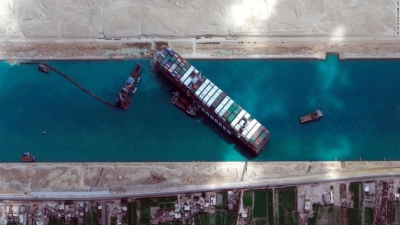
On 23 March, 2021, an ultra large container ship called Ever Given ran aground wedging itself diagonally across the Suez Canal, after strong winds allegedly blew the ship off course. The ship, operated by Taiwan-based Evergreen Marine, was en route from Malaysia to the Netherlands. It blocked traffic in either directions, leaving hundreds of other vessels gridlocked as they attempted to transit between the Red Sea and the Mediterranean Sea.
How did it happen?
Forty-five minutes after the vessel entered the Suez Canal from the Red Sea on March 23, it was thrown off course due to strong winds and a sandstorm which caused low visibility. The ship ended up with its bow (front) wedged in one bank of the canal and stern (back) nearly touching the other.
While some experts said that the ultra-large size of the Ever Given could have increased its risk of running aground, others said a combination of factors including potential loss of power and steering trouble could be a reason.
An investigation was underway. Bernhard Schulte Shipmanagement the company that manages Ever Given, said that initial investigations ruled out any mechanical or engine failure as a cause of the grounding.
Ever Given was set free after six-long-days of salvage efforts involving tug boats and dredgers much to the relief of the world.
While normal traffic resumed, the ship blockage resulted in massive economic loss hundreds of ships ferrying cargo worth billions were either stuck in traffic or forced to reroute, causing significant delays in essential shipments.
What is Ever Given like?
At 400 metres in length, the Ever Given vessel is longer than the Eiffel Tower laid on its side. Built in Japan about three years ago, Ever Given is registered in Panama. The cargo vessel carried over 20,000-odd containers and weighed some 220,000 tonnes.
What is the Indian connection?
The entire 25- member-crew of Ever Given is Indian. All the members are safe and accounted for.
How was it refloated?
Salvage/rescue teams from Japan and the Netherlands were called in to help in the daunting challenge of refloating the Ever Given. A flotilla of 13 tugboats were employed, which tried to dislodge the ship by pushing and pulling it away from the banks, with the help of the ship’s own winches. In addition, dredgers were brought in, which dug 30,000 cubic metres of mud and sand from beneath the ends of the ship. As conventional earthmoving equipment worked on shore, tugboats and dredgers were busy in the water.
At one point, it was considered to remove some 18,000 containers from the ship to lighten the load. But it was not done as the process could take more days. Finally, it was the high tides on the Full Moon Day (March 28) which helped expedite the process. On March 29, the stern of the ship was freed and the ship swung across the canal. Hours later, the bow too came unstuck, and the Ever Given was able to move out
(*Tugboats are specialised boats that help ships “park” in ports and assist larger ships in moving in and out of berths. They can push or rotate ships by direct contact or pull them with heavy cables called tow lines.
* Dredgers are ships equipped with machines to remove underwater sand and sediments.)
Why did it matter?
Over 10% of global trade, including 7% of the world’s oil, passes through the Suez Canal. After the blockage, the price of international benchmark Brent crude shot up some 3% to $63 a barrel. Shipping journal Lloyd’s List estimated that $9 billion worth (more than Rs 65,000 crore) of goods was disrupted each day that the vessel remained stuck.
Many ships were rerouted through alternative ways to avoid the Suez Canal at the cost of extra time and fuel.
The Guardian reported that, in addition to the economic implications, experts were concerned about security threats to idling ships in the Red Sea as they could become targets for attacks amid ongoing tension between Iran and the U.S.
Why is the Suez Canal an important shipping channel?
- Built in 1869, the Suez Canal is an artificial waterway that runs across the Isthmus of Suez in Egypt connecting the Mediterranean and the Red seas. The Suez Canal is operated by Egypt, through its state owned Suez Canal Authority. The 193-km canal separates the African the shortest maritime route between Europe and the lands lying around the Indian and western Pacific oceans. Without Suez, a supertanker carrying Mideast crude oil to Europe would have to travel an extra 6,000 miles around Africa’s Cape of Good Hope, adding some $300,000 in fuel costs. continent from Asia, and it provides A view of Ever Given ship. PHOTO: AP
- The Suez Canal is one of the world’s busiest shipping channels that’s vital for the movement of oil, liquified natural gas from the Persian Gulf and furniture. clothes and supermarket basics from Asia.
- It also remains one of Egypt’s top foreign currency earners. In an effort to increase traffic the Egyptian government undertook an $8 billion expansion of the Canal in 2015. In 2020, 19,000 ships passed through the canal-more than 50 ships per day.
- There have been instances in the past, when the canal has been closed temporarily. The reasons have mostly been war. But on two occasions, it has been closed for traffic due to ships running aground – When the oil tanker Tropic Brilliance got stuck in 2004 for three days and when OOCL Japan ran aground for a few hours in 2017.
Picture Credit : Google



